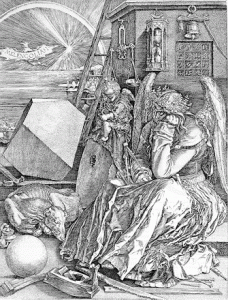Albrecht Durer’s Melencolia

Interpretation of this Drawing (by John Read)
Early in the sixteenth century, the famous German artists and engravers, Albrecht Durer and Lucas Cranach, were influenced to some extent by alchemical ideas and symbolism, but they left no pictorial impression of an alchemist or his laboratory. Durer (1471-1528), one of the two greatest artists Germany has ever produced, was particularly skilled in drawing on the block for the wood-cutter and in engraving on copper with his own unsurpassed hand. In 1513 and 1514 he wrought three engravings on copper that will rank for all time among the world’s select masterpieces of this form of art. These were “The Knight ” (1513), “St. Jerome in his Study” (1514), and “Melencolia” (1514).
There is no evidence that Durer had an acquaintance with alchemy so intimate as, say, that of Chaucer in an earlier age; nevertheless, alchemy formed an essential ingredient of the cultural background of his times. To contemporary men of culture in general, as to the alchemist in particular, the “Melencolia” must have appeared as a rich repository of the pictorial symbolism of alchemy.
The Roman numeral “I” following the engraved title suggests at once that Durer had it in mind to design and execute a series of four copper-engravings illustrating the Four Temperaments: melancholic, phlegmatic, choleric, and sanguine. These were linked in the medieval mind with the Four Elements of the alchemists and certain other mystical groups of four, a magical number inherited from the early civilizations that flourished long before the time of Pythagoras.
The Four Temperaments were connected immediately with the Four Humors of the body (black bile, phlegm, yellow bile, blood). Somewhat more remotely, they were connected with the four outstanding colors that indicated the stages of alchemy (black, white, citrine, red). The number four is emphasized in the magic square shown so prominently in Durer’s design. This magic square of the fourth order (i.e., containing the consecutive numbers 1,2,3,4 and adding up in various directions to a constant sum) shows the date of the engraving (1514) in the middle cells of the bottom row. Similar magic squares of the orders three through nine were constructed by Durer’s contemporary, Cornclius Agrippa, and assigned to Saturn, Jupiter, Mars, Sol, Venus, Mercury, and the Moon. Such squares were sometimes engraved on plates of the corresponding metals and worn as amulets.
The rainbow, seen in the background, was the alchemist’s favorite symbol for the colors that were held to appear, in a definite sequence culminating in red (within the Vase of Hermes) during the operations of the Great Work or in the preparation of the Philosopher’s Stone. The magic square, the compasses, the polyhedron and sphere, all reflect the Pythagorean insistence on the importance of number and form in the Cosmos. The Pythagorean and Platonic conceptions formed an important constituent of alchemical doctrine; further, the compasses, the balance, and the hour-glass, with its graduated scale, are suggestive of a common alchemical dictum, borrowed from The Wisdom of Solomon: ” Thou hast ordered all things in measure and number and weight.”
The alchemical significance of the crucible requires no explanation, for this most familiar of all pieces of alchemical apparatus was to be found in every alchemist’s laboratory, den, or kitchen. The most familiar agent used by the alchemists in their operations was fire; so much so, that the alchemist was often called the “Child of Fire.” Fire was commonly symbolized by cutting, penetrating, or wounding implements and tools, like the saw and plane and the hammer and nails of Durer’s design. The alchemical imagination embodied archetypal Fire in another form as Sophic Sulfur, one of the two final ingredients of the Philosopher’s Stone, and occasionally shown in the similitude of a dog.
The second ingredient, Sophic Mercury, was sometimes represented by Water ; that is to say, “our Water” of the Hermetic Stream (or heavy water, not wetting the hands). Alternatively, this philosophical Water was regarded as a menstruum uniting Sophic Sulfur and Sophic Mercury. Occasionally, the seeker after the Stone is shown balancing the opposed elements, Fire and Water, in a pair of scales, and at one time it was imagined that, in alcohol, such a combination of irreconcilable principles had been achieved.
The seven-runged ladder is another common feature of alchemical symbolism, the rungs representing the seven metals, the operations of alchemy, and the associated heavenly bodies. One of the paintings of Splendor Solis (1582), for example, shows a man standing on the sixth and seventh rungs (representing silver and gold) and gathering the golden fruit of the Philosophic Tree, from the roots of which issues the Hermetic Stream. In the later Mutus Liber a young man, using a stone for his pillow, is shown asleep at the foot of a ladder bearing ascending and descending angels; this stone, upon which the biblical Jacob poured oil, was sometimes accepted as a symbol of the Philosopher’s Stone.
We now come to the central theme of Durer’s “Melencolia.” The alchemist’s lot was such that he was often depicted as a melancholy and frustrated being, as, for example, by Chaucer, Weiditz, Brueghel, and Teniers. In a wider sense, melancholy was held to be an attribute of students or seekers after knowledge. The doctrine of melancholy, moreover, is inseparable from the Saturnine mysticism that permeates alchemy. This association, which was widely recognized in the early sixteenth century, finds many reflections in Durer’s masterpiece. One of the elements of Saturnine mysticism is measurement, typified by the compasses, balance, and hour-glass.
The polyhedron lying beside the foot of the ladder (representing the base metal, lead) may be an image of the Philosopher’s Stone, or more immediately, of the so-called ” Stone of Saturn,” which Saturn (or Kronos), “swallowed and spewed up instead of Jupiter.” Saturn, who is often represented in alchemy as an old man with an hour-glass upon his head, was addicted to swallowing his own children; for this reason, infants, usually shown at play, enter into the Saturnine elements of alchemy.
It is frequently stated in the esoteric writings on alchemy that once the primitive materials of the Stone have been obtained, the rest of the operations of the Great Work are only a labor fit for women or “child’s play.” This ludus puerorum (child’s play) motive often comes to the surface in sixteenth century art, as, for example, in the work of Durer’s contemporary, Cranach. The infants may be linked on the one hand with the alchemical idea of regeneration, and on the other with the mythological story of Saturn and thus with the idea of melancholy.
For example, all three of Cranach’s representations of Melancholy show infants at play. In the first (1528), four infants are romping with a dog, a sphere and compasses being shown in the background; in the second (1532), two of three infants are trying to lever forward a large sphere, the third has a hoop, and there is a dog in the background; in the third (1533), fifteen infant boys are shown at play, most of whom some are dancing and two are playing on the flute and drum. There are also other examples in alchemy suggesting the use of music as an antidote to melancholy. Furthermore, one of the paintings of Splendor Solis (1582) shows ten infant boys at play, and the accompanying bath provides still another link with the Saturnine mysticism, which was often associated with moisture or wetness. Thus Saturn, in the guise of a crippled or wooden-legged man with a watering-pot, is sometimes shown watering the Sun Tree and Moon Tree of the alchemists. The crippled Saturn symbolizes the slow and melancholy planet, Saturn, and the dull and heavy metal, lead, with which the planet was associated in alchemy. Again, the “labor fit for women” is frequently brought out in alchemical pictures of washerwomen engaged in their humid operations. From this point of view it is interesting that Durer’s design has a watery background.
The sphere and hoop associated with Cranach’s infants are suggestive also of change and regeneration. They may perhaps be linked with that still older symbol of ancient Egypt, the Ouroboros, the serpent biting its own tail, signifying eternity. Other alchemical conceptions closely bound up with the sphere and hoop, and the grindstone upon which Durer’s infant is sitting, are those of the Philosopher’s Egg or Vase of Hermes, and the circulation within it of the materials of the Great Work. The bulging purse at the foot of Durer’s main figure may also be likened to the purse into which one of three winged infants is dropping coins, in the celebrated alchemical interior of the artist Terriers; in the same painting a large soap-bubble hovering in the air is reminiscent of the sphere in the compositions of Durer and Cranach. The rolling sphere, hoop, or grindstone may also be connected with the famous second precept of the Emerald Tablet: “What is Below is like that which is Above; and what is Above is like that which is Below, to accomplish the miracles of One Thing.
Durer’s brooding figure, posed in an attitude of dejection and frustration, with a sad, leaden, downward cast, may be interpreted as an embodiment of the alchemical searcher after the ephemeral Stone — or, in a wider sense, as the seeker after wisdom — in a mood of temporary defeat. The atmosphere of lassitude and gloom is intensified by the tolling bell, the quiescent infant, and the lean and passive hound. Despite the opening keys and the light-giving lamp, knowledge comes, but wisdom lingers.” Yet, “we fail to rise, are baffled to fight better.” In the distance, dispelling the black bat, night, shines the sun over the Saturnine Sea and if, like the Saturnine symbols of alchemy, the winged genius of Melencolia broods with darkened face.





